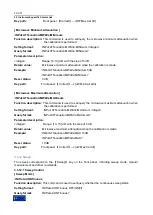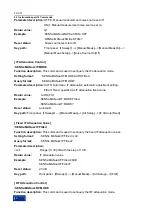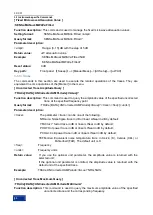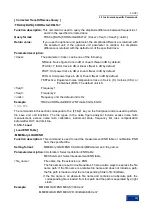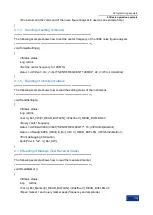
3 SCPI
3.3 Instrument-specific Commands
93
[ Corrected Trace Difference Query ]
:TRACe[:DATA]:CORRected:DELTa?
Function description:
This command is used to query the amplitude difference between frequencies 1
and 2 in the specified corrected trace.
Query format:
:TRACe[:DATA]:CORRected:DELTa? <trace>,<freq1>,<freq2>[,<units>]
Return value:
If you use the optional unit parameter, the amplitude difference is returned with
the selected unit; if the optional unit parameter is omitted, the amplitude
difference is returned with the default unit of the specified trace.
Parameter description:
<trace> The parameter <trace> can be one of the following:
NFIGure: Noise figure trace in dB or linear LINear in dB by default;
YFACtor: Y factor trace in dB or linear LINear in dB by default;
PHOT: Hot power trace in dB or linear LINear in dB by default;
PCOLd: Cold power trace in dB or linear LINear in dB by default;
TEFFective: Equivalent noise temperature trace in Kelvin (K), Celsius (CEL) or
Fahrenheit (FAR). The default unit is K.
<freq1> Frequency1
<freq1> Frequency2
<units> Frequency unit, the default unit is Hz
Example:
:TRACe:CORRected:DELTa? NFIGure,5GHz,6GHz
3.3.14 File
The commands in this section correspond to the
【
File
】
key on the front panel and are used to perform
file save and call functions. The file types in the noise figure analyzer include excess noise ratio
measurement, excess noise ratio calibration, instrument state, frequency list, loss compensation
before/after DUT, and limit line.
3.3.14.1 Load
[ Load ENR Table ]
:MMEMory:LOAD:ENR
Function description:
This command is used to load the measurement ENR table or calibration ENR
from the specified file.
Setting format:
:MMEMory:LOAD:ENR CALibration|MEASurement,<file_name>
Parameter description:
CALibration: Select calibration ENR table
MEASurement: Select measurement ENR table
<file_name> File name, the file extension is .ENR.
The file names are put in double quotes. There are two ways to express the file
name path: if the file name is a relative file name and does not include a path,
the file path is loaded under the corresponding folder of D:\EnrData;
If the file name is an absolute file name and contains an absolute path, the
corresponding file is loaded from this path and the path is separated by a right
slash.
Example:
:MMEM:LOAD:ENR MEAS,”346C.enr”
:MMEM:LOAD:ENR MEAS,”D:\EnrData\346C.enr”






